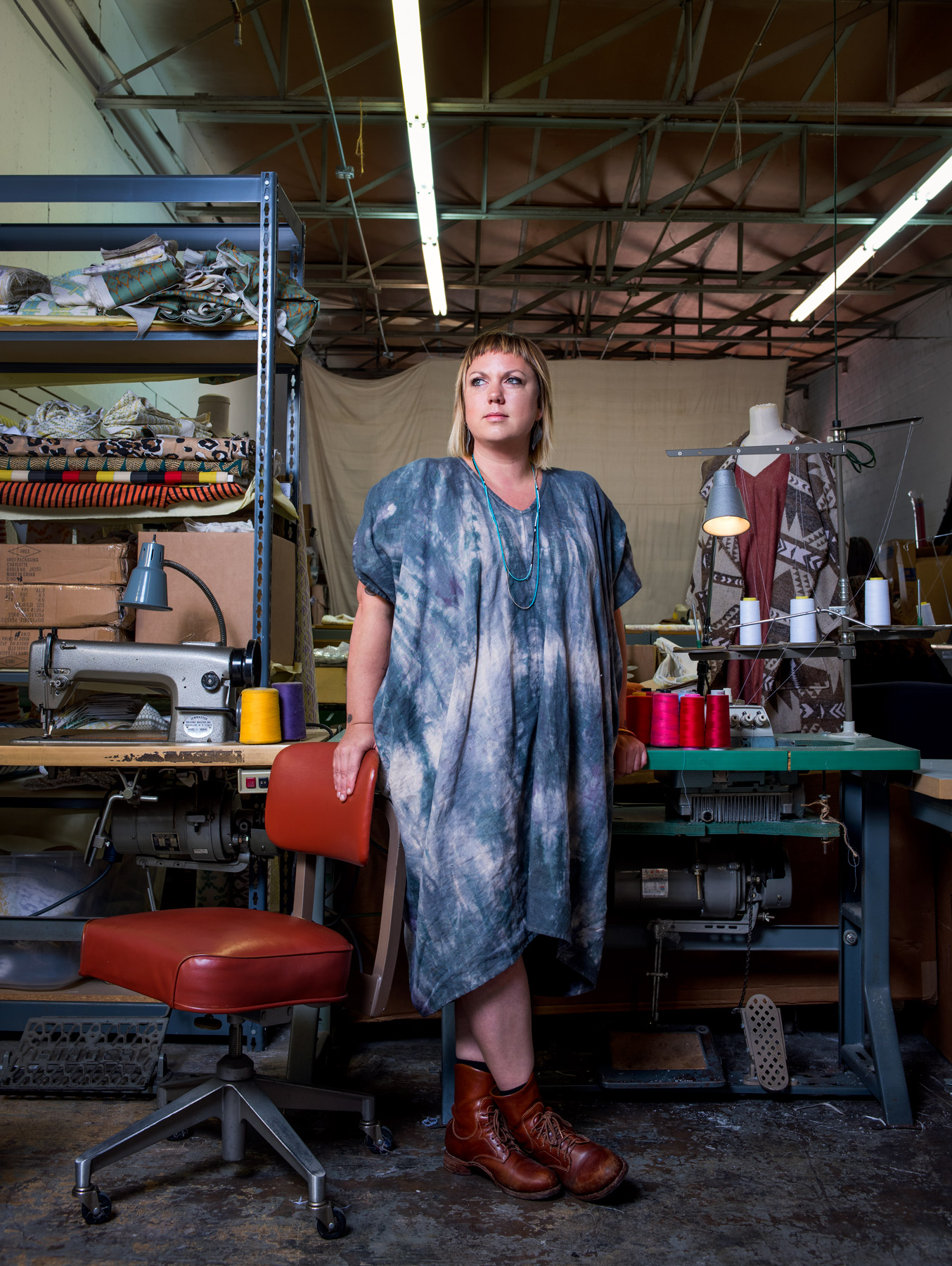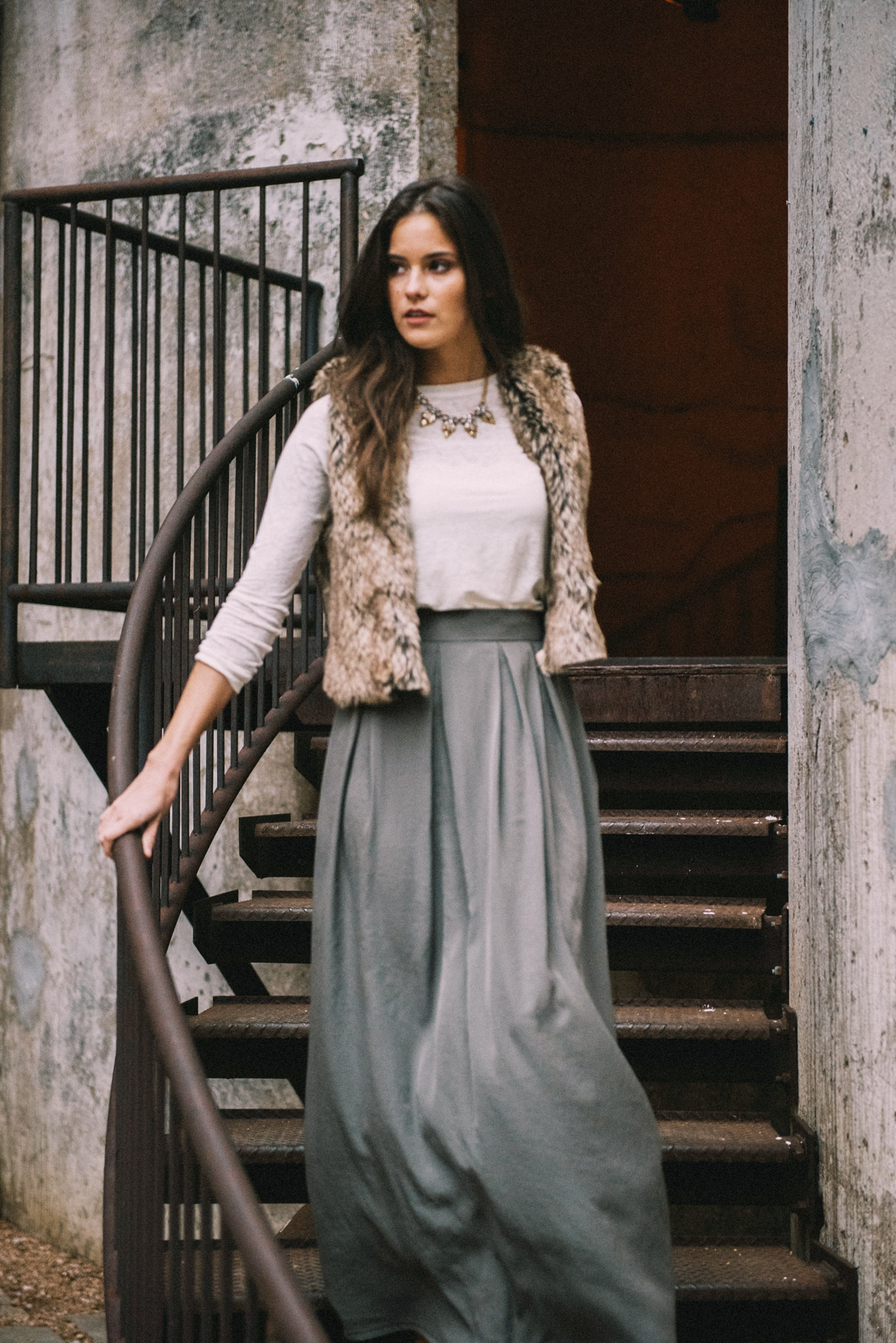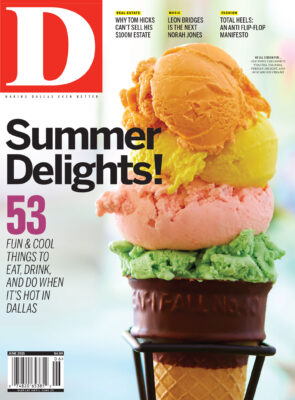Stubble-bearded, self-confident Matt Alexander, a 27-year-old Brit born of a Galveston mother, is on his way to becoming a titan of industry—or else he’s gathering material for a novel about failures in the start-up economy. After graduating with an English degree from SMU in 2010, he for a while held a communications job at Southwest Airlines. Then he founded a business consultancy before he took up daydreaming in the WELD co-op work space. Today he operates a company whose material assets consist of a few Apple laptops. The firm does, however, operate two websites that claim more than 250,000 registered users, and in May it attracted a $300,000 investment from several founders of CIC Partners, the private equity firm co-founded by Mayor Mike Rawlings.


In February, Alexander launched his second site, Foremost, which sells more moderately priced Dallas-made informal wear for both men and women in the twentysomething crowd. Though he believes its wares could garner mass appeal, today Foremost produces just 60 to 100 copies of each of its designs. A half-dozen staffers, most of them recent graduates of Dallas colleges, are on its payroll. They do their work on the aforementioned laptops, seated face to face at a long table in a Design District warehouse. To sharpen the company’s boutique-on-the-web strategy, employees enclose a handwritten thank-you note with every package they ship. Every 30 days, Alexander replaces Foremost’s designs with new ones, all created by a woman named Claire Johnson, 23, a graduate of Dallas Baptist University who nine months ago had no experience in couture. That didn’t trouble Alexander. Ordinary credentials don’t impress him.
“I’ve never read a résumé,” he says. “What I look for in people is passion and drive.” His study of start-up operations came about through barroom and cafe encounters, not tomes like those Barnes & Noble sells. “I don’t read business books, because if you do that,” he says, “you’re just following somebody else’s pattern for success under circumstances that no longer exist.” Most business strategy, he figures, is like “overpacking while traveling.” “If you write a 50-page business plan, the first time you run into a problem, you’ll just stick to what you were doing. For me, it’s always been about something that explains your vision, not a blueprint.”
Curated shopping was already old hat by the time Alexander launched Need. Even Amazon was a product aggregator. Web-based clothing sites were aplenty before Foremost, too, but because of his literary background, Alexander noted a flaw in what he saw: online sales pages lacked the power of words. “They were not presenting their products in an interesting or inspiring way,” he says. “There was no real photography or writing.”
Need and Foremost’s pages, in comparison, are both text-heavy and loaded with imagery. Foremost is built around video and print interviews in which young photographers, actors, and other creative types discourse on their budding careers. In the second edition, Ellar Coltrane, the boy from Boyhood, talked about whether he self-identifies as an actor. For Need, Alexander writes blog-like commentary. Here’s why his site offered a simple leather camera strap: “I’m still grappling with the fact that—whilst wearing that camera around my neck—I look like an oddly curious tourist. I could be walking through my own home with the camera and it’d still look like I’d just inadvertently meandered away from some sort of horrendous audio tour. The perpetrator of this travesty? The colorful, heavily branded strap.” Alexander’s idea is that Need and Foremost should attract a cult following, like magazines whose readers subscribe because reading them is a component of their personal identities.
His seemingly extemporaneous business strategy and his vision for the future perhaps make sense—from an English major’s point of view, anyway. Not many novelists base their works on plans, projections, or specifications. Instead, they make up stories as they go along. That’s what he did at SMU, where Alexander was designated a “distinguished graduate” in literature. “I never knew what was going to happen or how the story was going to end,” he says. “It was always just about whatever came to mind.” In a course where students were told to prepare an outline for a first class meeting, and to compose an essay for the next, Alexander wrote his essays first and drew his outlines from them. Because he turned in the outlines first, nobody knew the difference.
Alexander’s idea for Need came to him during a pub chat in London, and Foremost was only an inkling until a visitor to his Dallas office said that he was planning to manufacture men’s pocket squares here. “I knew there was a pressing demand for affordable men’s and women’s clothing, but I had thought that we’d have to produce maybe 3,000 copies of each garment and go to Atlanta or L.A.,” he says. “When I learned that garments were still being made in Dallas, I asked him, ‘Can they do 100 of these?’ It all kind of came together then.”
Matt Alexander’s discovery that the city’s decimated and nearly invisible garment trade still had capacity held out the promise that he could make money if he could find the people who still make not plans, but things. He found a world populated by scarred and aging veterans of the industry and by the rank young upstarts who have moved into its ruins.
Matt Alexander found a world populated by scarred and aging veterans of the industry and by the rank young upstarts who have moved into its ruins.
Early one morning in 1952, 22-year-old Joe Allen boarded a bus in Shreveport. He was bound for Dallas, looking for a job. The Missouri native had been through the city only once, 18 months before, on a trip from Wichita Falls to Louisiana. “Dallas was the biggest thing I’d ever seen,” the 84-year-old says today. “That Magnolia Building, you could see it for miles.”
In Shreveport, just as in Wichita Falls, he’d been a cutter and marker—a man who traced patterns onto fabric with a tailor’s crayon—in a factory that made men’s work clothing. But the plant’s cutting room was in a basement that housed boilers used for pressing finished garments. After a mysterious bout of paralysis, he’d decided that he was sweating himself to death.
Allen was personable and outgoing, with a strong handshake, a booming voice, and a broad, toothy smile. Upon his arrival in Dallas, Allen went to the Texas Employment Commission, which had a half-dozen counselors assigned to openings in the garment trade. They gave him a street map and a list of companies that were looking to hire. “It was all easy, because everything was still located downtown,” Allen says. He had a job before the sun set.
The Dallas garment industry was into its second generation by then. It had been founded in the teens by menswear manufacturers but by 1930 had found a more secure spot turning out simple cotton “house” or “wash” dresses suited to the mild Southwestern climate and the tastes of its mom-and-pop retailers. The WWII years had been boom times, thanks to government contracts for men’s and women’s military uniforms. Meanwhile, on the home front, a mood of distaff independence had blossomed, inspiring a new family of postwar garments dubbed “women’s sportswear”—not one-piece dresses, but blouses, pants, and mix-and-match outfits. Women’s sportswear put Dallas on the map when two national retailers, J.C. Penney and Sears Roebuck, opened buying offices here.

Allen’s employer was the Stockton Manufacturing Company, one of the bigger firms of the day. He learned the skills of pattern-making and “grading”; graders altered size-10 patterns to fit across the range of body shapes. Before long, he became a production manager, doing everything but buying the fabric.
Estimates were always unreliable, but by 1960, industry association counts put the number of Dallas manufacturers that produced their own fashions at about 200, though some “didn’t even list themselves in the Yellow Pages, because they didn’t want to bother with buyers from mom-and-pop stores,” Allen says. No estimate of contractors was made because, as 95-year-old former fabric salesman Harvey Ladd puts it, “so many were hiding in garages,” mostly from taxing authorities.
The city’s products were aimed at the middle of the mass market, “Champagne styling at working-girl prices,” one firm’s advertisement said. Dallas designers were known mainly for copying fashions, not for originality. “New York knocked off Paris, and we knocked off New York,” Allen says.
During their glory days, local manufacturing associations urged their members to establish the city as a brand by labeling their garments “Made in Dallas.” In November 1963, the Kennedy assassination changed that. “There was an awful lot of backlash,” says Jay Lorch, 84, scion of one of the city’s founding garment shops. Allen says, “We started getting calls from retailers who were saying, ‘My customers like your merchandise, but they don’t want to buy anything from Dallas. They hate Dallas!’ I had to destroy 200,000 ‘Made in Dallas’ labels.”
The 1964 opening of the Apparel Mart, in the Market Center complex, celebrated the industry’s crest. Manufacturers exhibited and sold orders to 80,000 dry goods buyers a year, some from Southern and Southwestern mom-and-pop stores, others from the headquarters of faraway chains. Oscar de la Renta, Bill Blass, Pierre Cardin, and other big-name designers showed there.
Perhaps it was indicative of the industry’s prestige that in the late ’60s, when Allen decided to start a company in which he held controlling stock, he was able to bring in an outsider, former Steelers and Cowboys wide receiver Buddy Dial. Though its first factory was in Ennis, the company was named Royal Park, after the street where Dial lived. Royal Park extended its operations until it operated five factories


by virtue of volume, were able to put price pressures on suppliers.
To discourage violations of child labor and minimum-wage laws, and as a favor to labor unions, the federal government had in 1938 regulated home sewing. But in acts of wily and calculated defiance, as early as 1980 Dallas dressmakers began to go outside the law, cutting back on work in their plants and hiring local contractors who recruited shadowy networks of home sewers—20,000 to 60,000 in the Dallas-Fort Worth area, according to a U.S. Department of Labor estimate, many of them Vietnamese immigrant housewives. Between 1994 and 1996 the department reported that 29 percent of 350 home-sewing contractors did not file income tax returns, and persuaded the city’s largest surviving manufacturer, Jerrel, along with the Penney’s and Dillard’s chains, to inspect contractor books and workplaces. It also ordered a dozen sweatshop and home-sewing operators to pay overtime hours and back wages.
Home sewing was in for a comeuppance anyway. By the late ’90s, not even its stealthy contractors could underbid the foreign factories to which the mass-market industry slowly turned after passage of the North American Free Trade Agreement. Ed Malouf, 89, a veteran of both the Dallas garment trade and the Battle of the Bulge, says that the numbers forced them to outsource work to Mexico. “Our share of FICA and Medicare payments for our workers was more than the take-home pay of workers in Mexico,” he says.
And Mexico was only a way station. With wages as low as 15 cents an hour in Malaysia, no locale outside Asia could compete. That put smaller manufacturers in a bind. One by one, local manufacturers, including Joe Allen, toppled into bankruptcy or shut down.
Allen went on to manage a firm that set a likely record production run: 8 million copies of a garment called the American Shirtwaist Dress. But then he learned that much of that stock was produced by home sewers. “That’s where we parted company,” Allen says.
•••
Rudy Romero, 59, is a link between the Dallas garment industry’s past and future. He is an ebullient Fort Worth native who began working as a cutter in Dallas garment shops at the age of 16. In 1988, he decided to go out on his own by founding a Design District shop, T&Q Cutting, that today produces everyday garb, cheerleader outfits, dance wear, bridal gowns, athletic uniforms, tote bags, even stuffed panda toys and outboard motor covers. Although he insists that he took the step into ownership for purely personal reasons, it made him the unwitting beneficiary of the shift to home sewing. Manufacturers were closing their factories, but home sewers and their contractors didn’t have the skills or machinery to cut patterns from fabric.
The eclipse of home sewing was a godsend to Romero, too. It brought early web merchants to T&Q. Two years ago, he added a 10-machine sewing room to his shop for clients like Heather and David Whiting, whose company, Moonbeam Baby, markets monogrammed onesies, bibs, and burp cloths. Both were working for a telecom firm, David as a financial officer, when gifts for the birth of their son gave Heather the idea of making baby-shower wares herself. She wound up creating a company that he joined four years ago.
“It kind of grew from a hobby into a small operation,” David says. “She started making things, and it grew from there.”
Initially, the couple’s web-based outlet sold items imported from Asia. But the Whitings encountered supply and logistical problems—overseas production is costly for small-batch operators—and they started the search that led them to Romero.
Alexander, as might be expected, went a bit further out on a limb. After Julie McCullough, 39, moved to Dallas from Chicago in 2001, she got interested in the needlework craft but couldn’t find classes to her liking. So she taught herself to sew, then set up a needlework academy in Oak Cliff before moving it to the Design District. For the past two years, she has operated a 10-machine sewing room, Make and Made, on Irving Boulevard, taking in small-batch orders and turning out garments she designs herself. She made the first edition of Foremost for Alexander.
Rudy Romero, whose new location is just minutes from Make and Made, is old-school. He still wears a denim apron at work. McCullough’s right shoulder bears a big tattoo depicting a spool of thread, scissors, a sewing machine, and a dress form.
Today’s Dallas garment industry looks a little like the past, but the differences are more than meet the eye. Today’s business is promotion-heavy and technologically light; yesterday’s was machine-centric and built around routines. McCullough and Romero hire fewer than 20 sewers; in Dallas’ garment heyday, a half-dozen factories employed 500 people each, and 50-machine contractors were common. Romero’s operation, whose biggest order has been for 15,000 garments, would have been noteworthy 30 years ago. And although the city’s garment industry is showing new life, no one has restored “Made in Dallas” labeling. The gaps between garment generations are wide and are not likely to be fully bridged, even in days to come. But the future is never quite here, and the past is never quite gone.
Write to [email protected].








